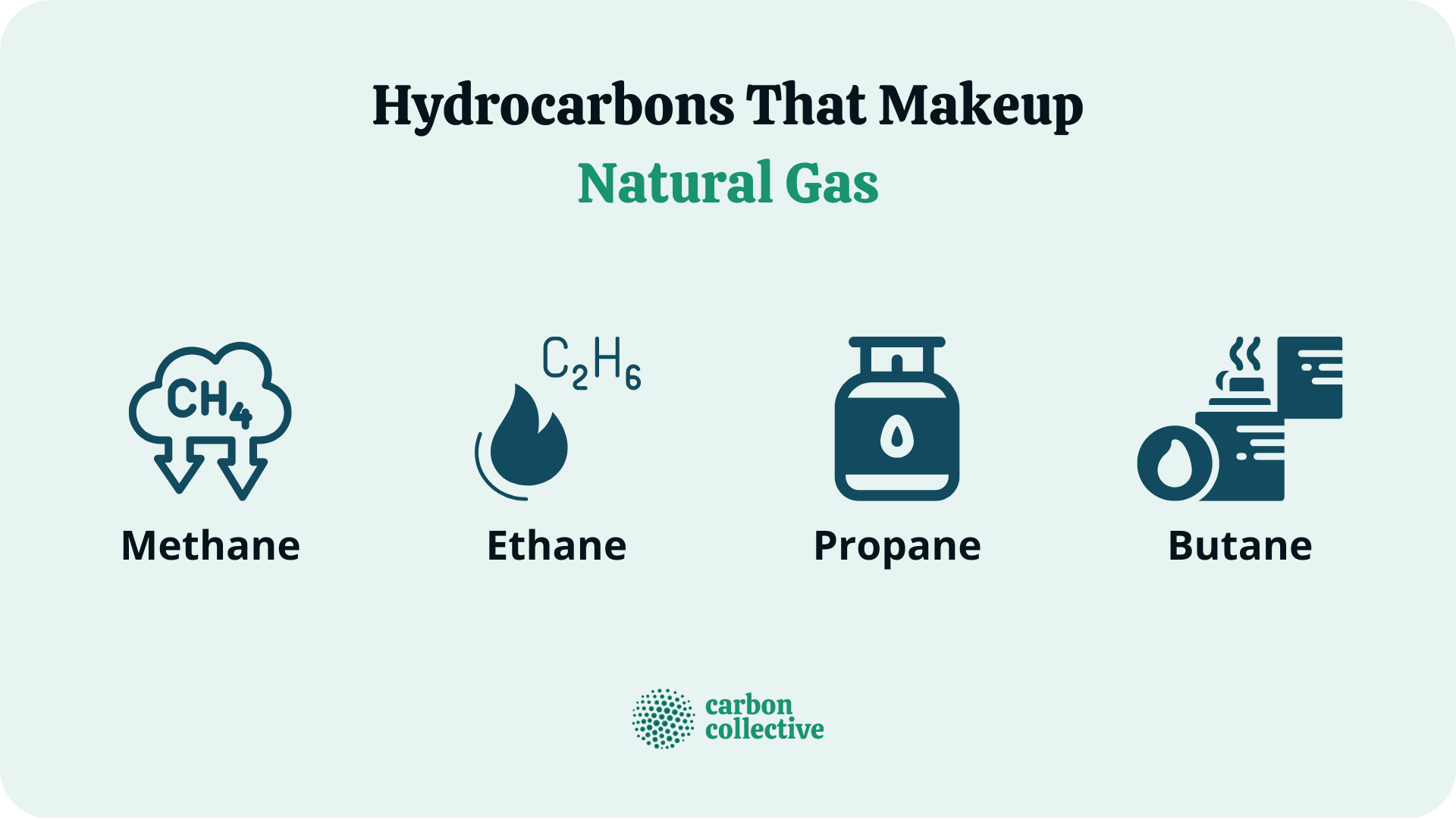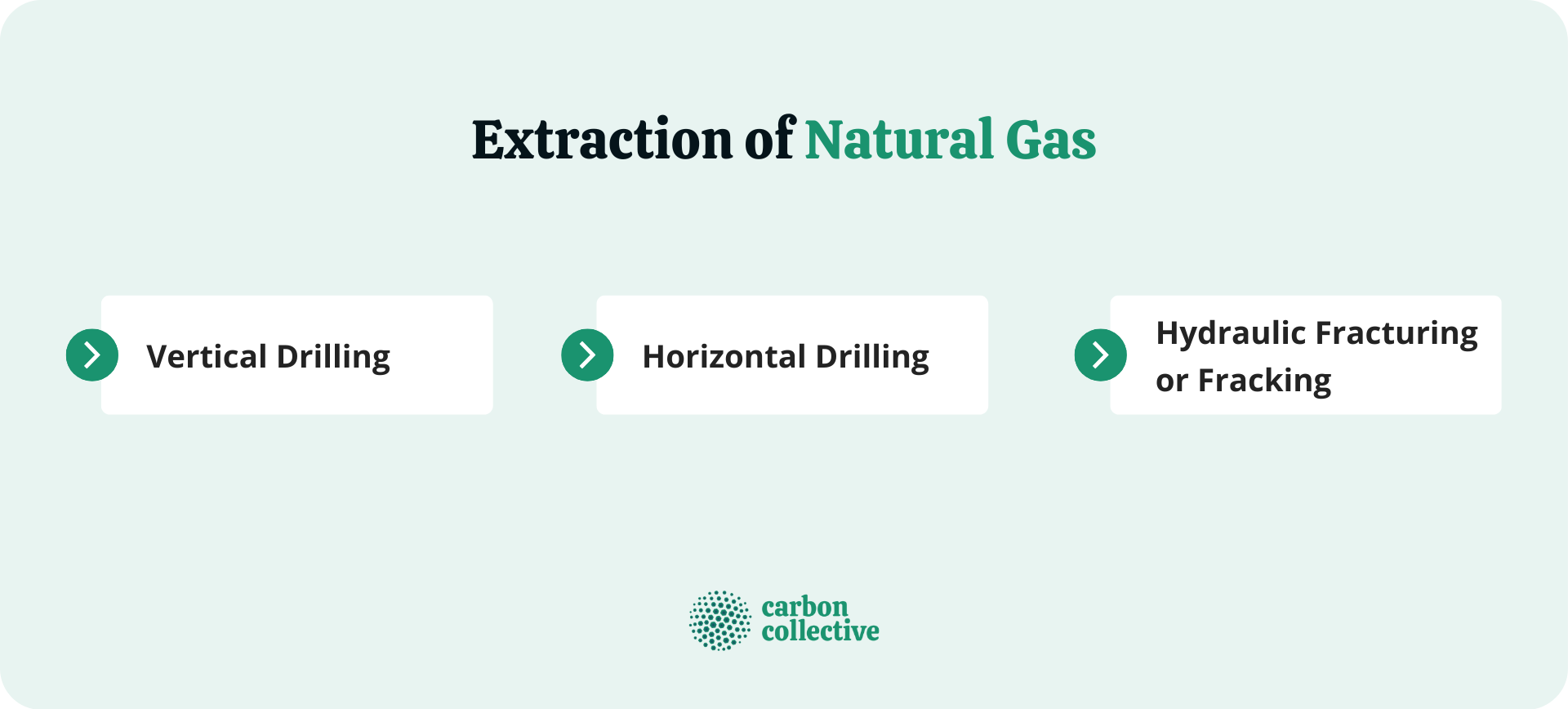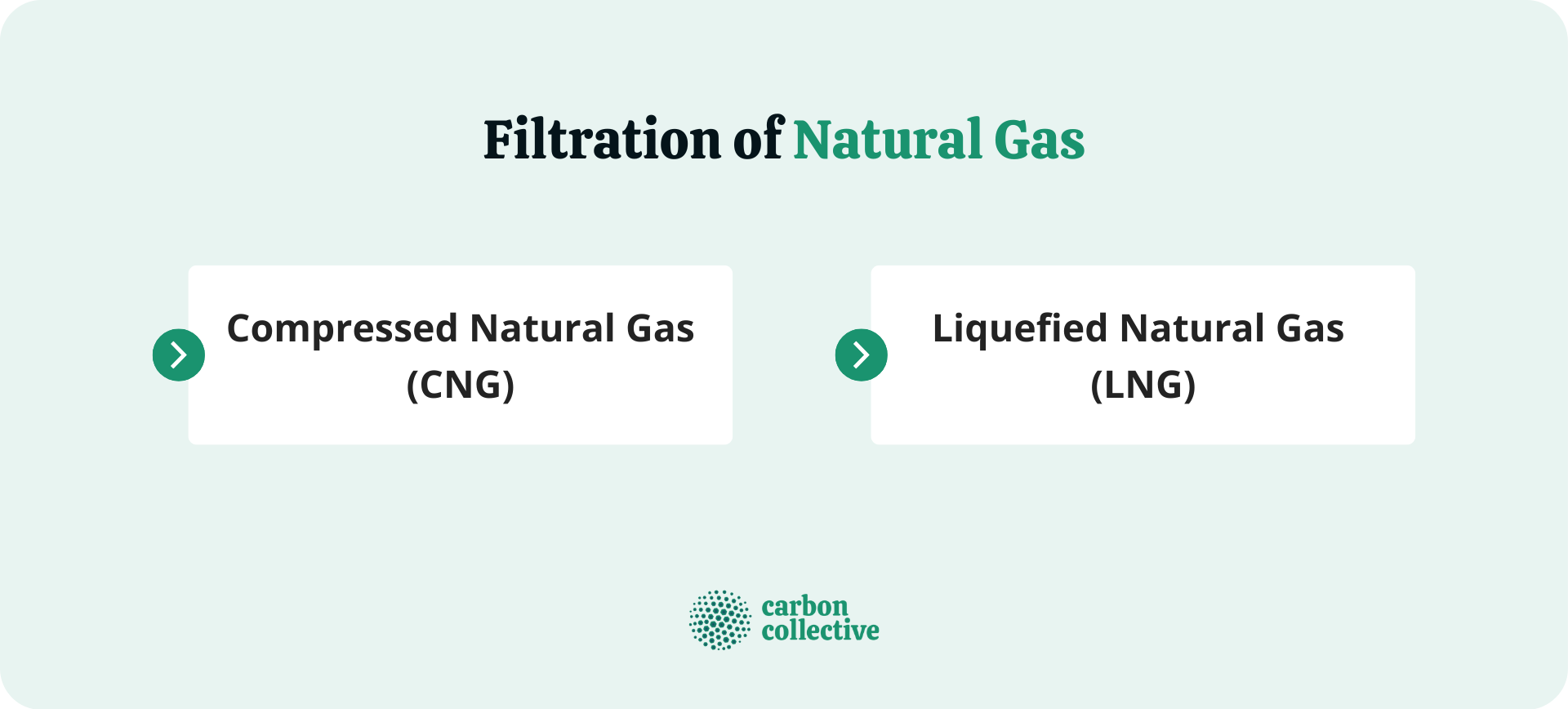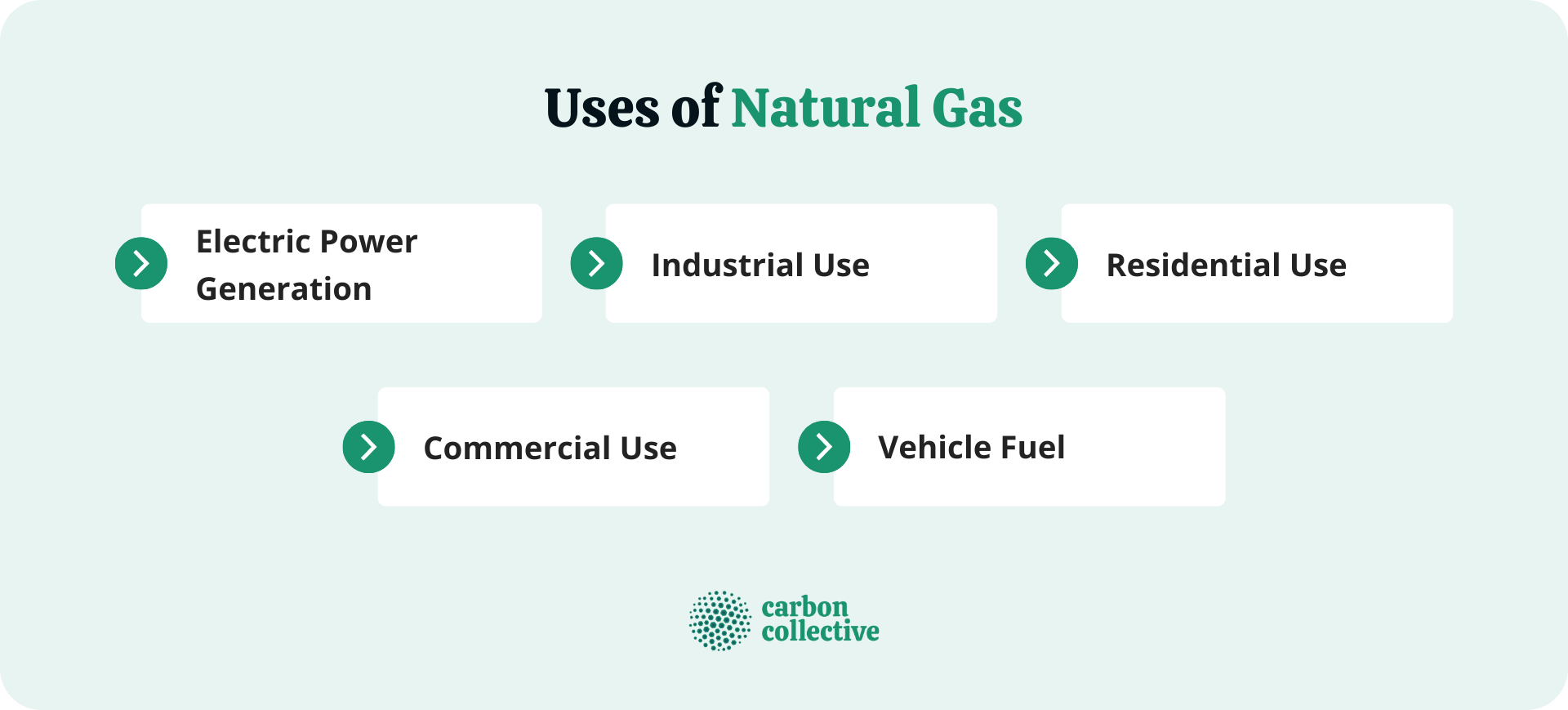What Is Natural Gas?
Natural gas is an odorless, colorless gas. It is primarily composed of methane (CH4) and very small amounts of other gases.
Methane, the main component of this gas, can be converted into more complex hydrocarbons. These may include ethane, propane, butane, and pentanes, some of which are more energy-rich than pure methane by weight.
Formation of Natural Gas
It has formed over the past several years from buried organic matter that was subjected to high heat and pressure in the Earth's crust. It is mainly from the remains of plants and animals from years ago that were trapped in the Earth's crust. Gradually, it became mixed with clay, sand, and gravel.
Over time, these organic materials decomposed into coal, oil, and natural gas as a result of high heat and pressure.
Hydrocarbons That Makeup Natural Gas

Methane
Methane is the main component of natural gas at around 80%. Its chemical formula is CH4. Methane is the simplest and most abundant hydrocarbon in natural gas.
Because of its odorless and colorless properties, smelly sulfur compounds are added to the methane so that leaks can be detected.
Methane emissions in the atmosphere have more than 80 times the warming power of carbon dioxide.
Ethane
The chemical formula for ethane is C2H6. Ethane's uses include fuel for industrial furnaces, heaters, and boilers. It is also an ingredient in the process of ethylene manufacturing as a petrochemical feedstock.
A petrochemical feedstock is a basic material used to make batteries, electric vehicle parts, medical equipment, and many other products.
Ethane is also a greenhouse gas but on a smaller scale compared to methane.
Propane
The chemical formula for propane is C3H8. Propane is used as a fuel in many industrial processes. It has many different uses such as fueling forklifts, heating homes, cooking food, and grilling meat.
Butane
The chemical formula for butane is C4H10. Butane is used as a propellant in aerosol spray products, and cooking fuel. It is also an ingredient in the process of making acrylic fibers.
It is highly flammable and can be explosive. It has a faint, disagreeable smell.
Where Is Natural Gas Found?
This gas can be found in rock formations such as shale, sandstone, and limestone under the Earth's surface.
Rock formations containing this gas are called reservoirs of natural gas. The rock formation must be porous enough to release the gas trapped inside. Also, if there is a fault line, it must run through where the rock formation is located so that it will also release some of its contents into the reservoir.
According to the U.S. Energy Information Administration (EIA), as of January 1, 2020, there are about 2,926 trillion cubic feet of technically recoverable resources of dry natural gas in the country. This is estimated to last for about 84 years given the current rate of production.
Extraction of Natural Gas

Vertical Drilling
Vertical drilling, true to its name, is drilling that happens straight down in a vertical direction. This is typically done when the drilling rig is located on the ground and the gas well is directly underneath. The drill bit is lowered into the well until it hits the formation that holds the gas.
Vertical drilling is the first method used to extract natural gas from the ground. It is also the easiest and most cost-effective method of extraction.
Horizontal Drilling
Horizontal drilling drills in an angled direction from its surface location down towards whatever depth target it has been set for.
This method saves time compared to vertical drilling. Compared with conventional vertical drilling, this process takes fewer steps to get at the same amount of deep-down gas resource.
Since horizontal wells can be drilled from a centralized location, it reduces time but costs more. This is because fewer roads need to be built and maintained just for one well site while crews transport equipment or materials to the well site.
Hydraulic Fracturing or Fracking
Hydraulic fracturing, commonly known as fracking, is a process used in extracting gas from shale rock formations deep underground. It has revolutionized how much can be potentially extracted compared with what was available decades before this period.
The process requires an extensive amount of planning, precision, and costs.
In fracking, a fluid mixture of mostly water with sand and various chemicals is injected into the well at high pressure. This is done to fracture the rock surrounding gas reservoirs. After which, pockets of natural gas trapped inside are released.
The sand is used as a "proppant" to keep the fractures open so more gas can be released from the reservoir even after fracking has stopped for a while.
Afterward, conventional vertical drilling techniques are implemented to extract what was fractured loose by the hydraulic fracturing process.
Filtration of Natural Gas
Filtration is the process of separating unwanted gases and other impurities. These include hydrogen sulfide, carbon dioxide, nitrogen, and water vapor from natural gas. The unwanted gases are then safely discharged into the atmosphere with just pure natural gas being collected by the pipeline.
Compressed Natural Gas (CNG)
Compressed natural gas (CNG) is primarily composed of methane that has been compressed into a gaseous form.
Compared to traditional gasoline, CNG has the ability to produce less greenhouse emissions when properly burned in an engine. This makes it environmentally friendly and is thus often used by vehicles that are part of government fleets.
CNG can be used for many different purposes such as cooking or home heating, power generation, and vehicle fuel.
CNG is a very suitable replacement for traditional gasoline with the added benefit of being less expensive.
It is easier to handle than liquefied natural gas (LNG).
Liquefied Natural Gas (LNG)
Natural gas cannot be transported from one location to another without being turned into LNG first. This is done by super-cooling gas so that it can be maintained in a liquid state while being transported over long distances.
LNG is methane that has been liquefied after being cooled to -260°F at atmospheric pressure using either zero-boil off plants or vaporization plants. It is then transported via tankers which are specially designed to contain this substance until it reaches its final destination.
Uses of Natural Gas
Natural gas has many uses that are continuously being developed as technology advances. Let us look at just some of the current uses for this substance.
Electric Power Generation
In 2021, natural gas is the largest source of electricity generation in the U.S. It accounts for about 32% of electricity generation across the country.
Industrial Use
As an industrial fuel source, this gas is used in chemical processing plants, petroleum refineries, glass manufacturing facilities, food processing operations, steel manufacturers, and aluminum producers.
Residential Use
Besides being used in several different types of installations such as furnaces, boilers, wall and floor furnaces, water heaters among others, natural gas is also largely used for cooking purposes in homes around the world.
Commercial Use
Commercial establishments such as hotels and motels use either LNG or CNG to power their kitchens. It is also commonly used in restaurants and other food services that need a reliable source of fuel for their kitchen appliances.
Vehicle Fuel
Natural gas can be converted into liquid form (LNG) but it can also retain its gaseous form when stored at high pressures inside tanks mounted on vehicles themselves. LNG is often used in transit buses, where it can power the vehicle itself.
It is also more environmentally friendly than traditional gasoline and diesel fuel sources.
Depleting Supply of Natural Gas
According to energy experts, we are already running out of accessible natural gas resources which will make its supply more expensive with time. This is due to environmental issues that arise from crude oil production which reduces the overall availability of the gas while increasing the overall cost of producing this commodity.
Severe increases in population and demand are the main driving forces behind the depletion of these gas sources.
If we do not begin to conserve this resource, we may be headed towards an uncertain future with steadily increasing prices for natural gas.
Conserving Natural Gas
The best way to conserve is by reducing demand.
This can be done by either using more fuel-efficient engines in cars or developing new technologies that reduce the need for gasoline and diesel fuel sources altogether but there are other options available too.
Using CNG as a vehicle fuel source reduces carbon emissions of greenhouse gases thereby significantly cutting down on pollution while also conserving on the use of scarce natural resources like oil and petroleum products.
Energy performance can easily be improved on both commercial or industrial buildings without drastically changing their current structure at all by:
- adopting better insulation methods,
- replacing old heating systems with newer and more energy-efficient ones, or
- employing the use of solar-powered heating or cooling units.
Another alternative is through biomethane which is derived by capturing methane gas created through the decomposition of organic wastes found in landfills or during the production of biodegradable materials.
Biomethane is not a fossil fuel but a clean and renewable energy source with an identical chemical composition to that of conventional natural gas. It can be used to produce electricity, heat water for homes or power vehicles, thus creating a new link in the energy production process without causing any damage to the environment.
Final Thoughts
The world's natural gas resources are being consumed, and therefore depleted at an unprecedented rate. Increasing demand has also caused several harmful environmental effects that threaten the world's ability to continue its production.
This means that if nothing is done about this issue soon or alternatives are not developed at the same time as new sources, we may start facing serious shortages in this commodity sooner rather than later which will lead to an increase in its market prices for consumers everywhere.
Therefore, implementing conservation methods both on the industrial front and especially on the consumer end are some of the best ways to ensure that global reserves last us for decades instead of years before running out completely.
FAQs
1. What are hydrocarbons?
Hydrocarbons are organic compounds that are used to create gasoline, diesel fuel, and other conventional fuels like natural gas. They can be found inside porous rock formations below the earth's surface known as oil reservoirs. These substances, when exposed to intense heat and pressure in the absence of oxygen for a very long period, change into hydrocarbons.
2. What is compressed natural gas used for?
CNG refers to any form of natural gas that has been pressurized so it can efficiently power vehicles instead of conventional oil-based fuels. It is less harmful to the environment than crude oil because this fuel source does not contain any sulfur, benzene, or lead and is completely biodegradable.
3. What is an alternative to natural gas?
One of the most popular forms of alternative natural gas comes from landfills where organic wastes decompose anaerobically in a process called biomethane. This methane-rich substance can then be captured and used in homes or vehicles since it has the same chemical composition as conventional natural gas.
4. Can the use of natural gas be phased out?
Natural gas is a non-renewable resource that has been deemed a necessary energy source. The only way to phase out its use completely would be through developing renewables like solar or wind power into stable and efficient energy sources that can produce the same amount of electricity as natural gas does regularly.
5. How can I help in conserving natural gas?
One of the best ways to conserve is to support campaigns that aim to reduce its use by promoting renewable energy sources as viable alternatives. Additionally, this will help protect the environment from further damage caused by the use of fossil fuels.


